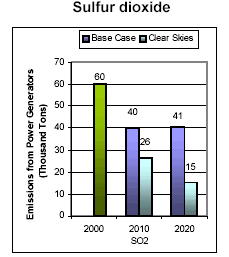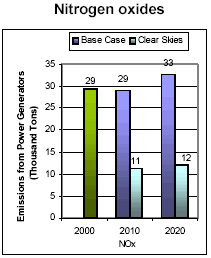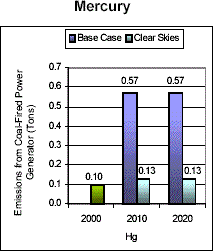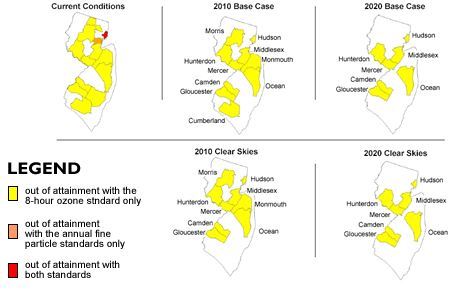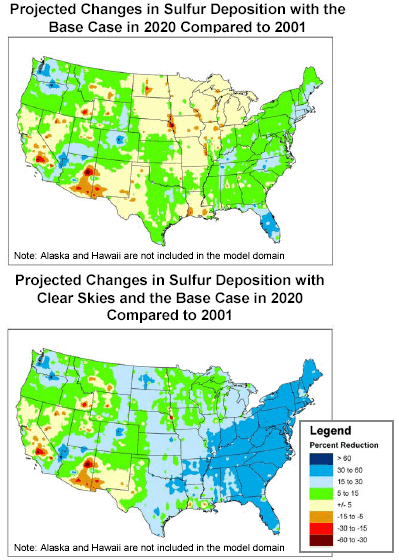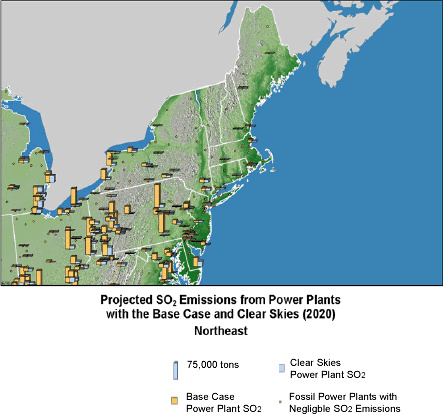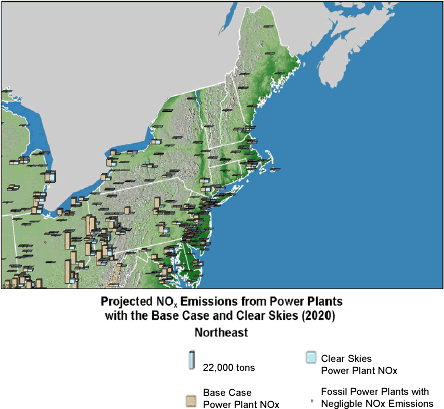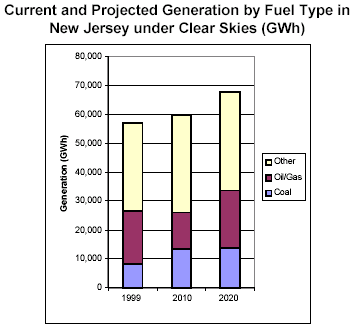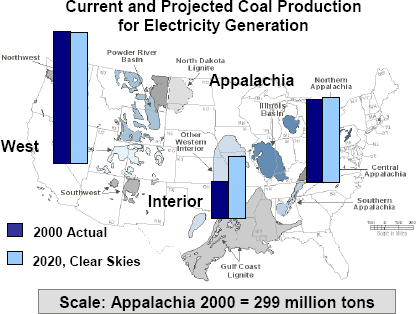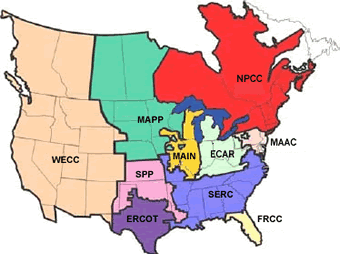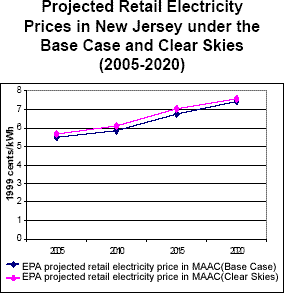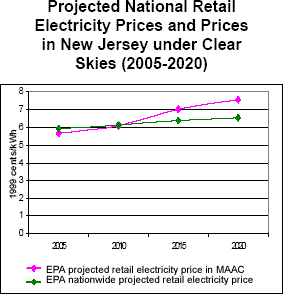Clear Skies
Clear Skies in New Jersey
Highlights of Clear Skies in New Jersey

- New Jersey sources would reduce emissions of SO2 by 62%, NOx by 63%,
and mercury by 78% due to Clear Skies.
- The health benefits in New Jersey would total $3.2 billion ($610 million
under the alternative estimate) and include 400 fewer premature deaths
(200 under the alternative estimate) and 700 fewer hospitalizations/emergency room visits for asthma.
- In addition, New Jersey would receive environmental benefits including
reductions in sulfur, mercury and nitrogen deposition, and visibility
improvements valued at $96 million for New Jersey residents who visit
National Parks nationwide.
- Clear Skies does not significantly impact electricity prices. With or without Clear Skies, electricity prices in the electricity supply region that includes New Jersey are expected to remain below 2000 prices.
Clear Skies: An Innovative Approach to Improving Human Health and the Environment
Why Clear Skies?
- Air quality has improved, but serious concerns persist
- New Jersey's citizens suffer ill effects from air pollution, including asthma attacks and premature death
- Electricity generation sector remains a major emissions source.
- Very cost-effective to control the power sector, relative to other sources.
- Sources are concerned about upcoming complex and burdensome regulations
Advantages of the Clear Skies Approach
- Guarantees significant nationwide emissions reductions . beginning
years before full implementation.
- New Jersey sources would substantially reduce emissions of SO2, NOx, and mercury.
- Delivers dramatic progress towards achievement of critical health and environmental goals
- Uses proven, market-based flexible approach with incentives for innovation.
- Recognizes environmental needs as well as industry constraints, allowing
industry to better manage
its operations and finances while lowering risks to the public - Sources are projected to install pollution controls to enable continued reliance on coal
- Recognizes environmental needs as well as industry constraints, allowing
industry to better manage
- Increases certainty across the board for industry, regulators, and consumers
Under Current Clean Air Act Power Plants Would Face a Complex Set of Requirements

For a larger image, click here.
Clear Skies Sets a Firm Timeline for Emission Reductions
| The existing Title IV SO2 cap-and-trade program provides an incentive and a mechanism to begin reductions upon enactment of Clear Skies years before regulatory action under the current Act. |
2004: The NOx SIP call (summertime NOx cap in 19 Eastern States + D.C.)
2008: Clear Skies NOx Phase I (2.1 million ton annual cap assigned to two Zones with trading programs)
2010:
- Clear Skies Hg Phase I (26 ton annual cap with a national trading program)
- SO2 Phase I (4.5 million ton annual cap with a national trading program)
2018:
- Clear Skies NOx Phase II (1.7 million ton annual cap assigned to two Zones with trading programs)
- Clear Skies Hg Phase II (15 ton annual cap with a national trading program)
- Clear Skies SO2 Phase II (3.0 million ton annual cap with a national trading program)
Emissions in New Jersey under Clear Skies
|
Emissions in New Jersey (2020) would be significantly reduced from 2000 levels:
|
|
Note: The base case using IPM includes Title IV, the NOx SIP Call, NSR settlements, and state-specific caps in CT, MA, MO, NC, NH, TX, and WI. It does not include mercury MACT in 2007 or any other potential future regulations to implement the current air quality standards or other parts of the Clean Air Act. Base case emissions in 2020 will likely be lower due to state and federal regulatory actions that have not yet been promulgated. Clear Skies Health Benefits in New Jersey
Improve Public Health
Counties Projected to Remain Out of Attainment with the PM2.5 and Ozone Standards in New Jersey Note: Based on 1999-2001 data of counties with monitors that have three years of complete data. The base case includes Title IV, the NOx SIP Call, the Tier II, Heavy-Duty Diesel, and Nonroad Diesel rules, final NSR settlements as of early spring 2003, and state-specific caps in CT, MA, MO, NC, NH, TX, and WI. It does not include mercury MACT or any other potential future regulations to implement the current ambient air quality standards or other parts of the Clean Air Act.
Clear Skies Would Help New Jersey Meet Air Quality Standards
Clear Skies Environmental Benefits in New Jersey
Clear Skies Would Provide Substantial Environmental Benefits in New JerseyIn comparison to existing programs,
* These results are based on modeling the ClearSkies mercury cap without the safety valve. SO2 and NOx Emissions Reductions under Clear Skies
Note: The base case in IPM includes Title IV, the NOx SIP Call, NSR settlements, and state-specific caps in CT, MA, MO, NC, NH, TX, and WI. It does not include mercury MACT in 2007 or any other potential future regulations to implement the current ambient air quality standards or other parts of the Clean Air Act. Base case emissions in 2020 will likely be lower due to state and federal regulatory actions that have not yet been promulgated. Emissions projected for new units in 2020 are not reflected. Electricity Generation in New Jersey under Clear Skies
Emission Controls in New Jersey under Clear Skies |
|||||
|
|
||||||||||||||||||||||||||
|
Notes: 1. Retrofits and total coal-fired capacity apply to coal units greater than 25 MW. 2. BL England unit 1 is projected to be removed from operation by 2005 with Clear Skies due to excess gas-fired capacity in the marketplace, unless otherwise needed forvoltage purposes. The recent overbuild of gas-fired generation reduces the need for less efficient units operating at lower capacity factors. These units are inefficient compared to other coal-fired plants and newer gas-fired generation. Less conservative assumptions regarding natural gas prices or electricity demand would create a greater incentive to keep these units operational. |
|||||||||||||||||||||||||||
Electricity Prices in New Jersey under Clear Skies
|
||||
Note: The base case using IPM includes Title IV, the NOx SIP Call, NSR settlements, and state-specific caps in CT, MA, MO, NC, NH, TX, and WI. It does not include mercury MACT in 2007 or any other potential future regulations to implement the current air quality standards or other parts of the Clean Air Act. Base case emissions in 2020 will likely be lower due to state and federal regulatory actions that have not yet been promulgated. Costs and Benefits in New Jersey under Clear Skies
Benefits Outweigh the Costs
Note: Costs include capital costs, fuel, and other operation and maintenance costs (both fixed and variable) associated with the achievement of the emissions caps in the legislation (for example, the installation and operation of pollution controls). These state-level production costs are estimates; they do not account for the costs associated with the transfer of electricity across regions, nor the costs or savingsthat could be associated with allowance movement between sources. Notes on EPA's Analysis
1. An alternative methodology for calculating health-related benefits projects approximately 200 premature deaths prevented and $610 million in health benefits each year in New Jersey by 2020.
|
||||

